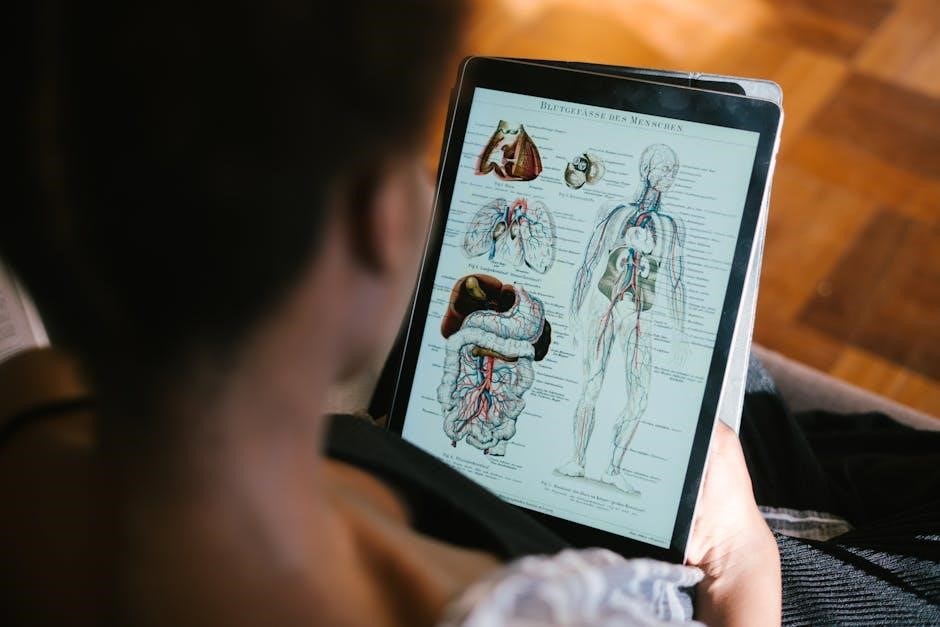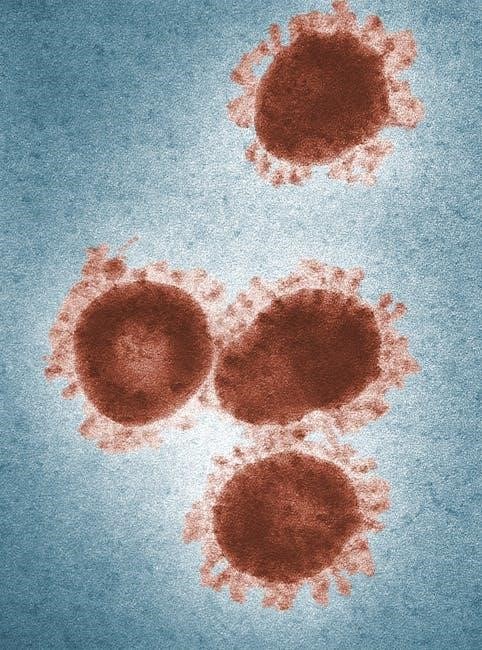The TEAS Science Study Guide PDF provides a free, comprehensive resource for exam preparation, covering key topics in biology, chemistry, and physics with interactive practice questions.
1.1 Overview of the TEAS Exam
The TEAS exam is a standardized test used for nursing and allied health program admissions, assessing academic readiness in reading, math, science, and English. It consists of 150 scored questions and 15 unscored pretest items, divided into four sections: Reading (42 questions), Math (30 questions), Science (53 questions), and English (28 questions). The exam evaluates essential skills and knowledge, with the Science section focusing on biology, chemistry, and physics. The test is timed, allowing 209 minutes for completion. A free PDF study guide is an invaluable resource for preparation, offering detailed content reviews, practice questions, and strategies to master the exam. Understanding the exam structure and content is crucial for effective studying and achieving a high score.
1.2 Importance of Science in the TEAS Exam
The science section of the TEAS exam is a critical component, accounting for 53 out of 150 scored questions. It evaluates knowledge in biology, chemistry, and physics, reflecting the foundational skills required for healthcare careers. Mastery of scientific concepts is essential for understanding human anatomy, physiology, and treatment principles. A strong performance in this section can significantly boost overall exam scores, enhancing eligibility for competitive nursing and allied health programs. Utilizing a free PDF study guide allows learners to focus on key topics, practice with sample questions, and develop effective test-taking strategies. This resource is particularly beneficial for identifying and addressing knowledge gaps in science, ensuring comprehensive preparation for the exam.
1.3 Benefits of Using a Free PDF Study Guide
A free PDF study guide for the TEAS Science section offers numerous advantages, making it an invaluable tool for exam preparation. It provides cost-effective access to comprehensive study materials, ensuring affordability for all learners. The guide is portable and easily accessible, allowing students to study anytime and anywhere. It often includes structured study plans, practice questions, and detailed explanations to reinforce learning. Additionally, a PDF guide enables self-paced learning, letting users focus on weak areas and track progress effectively. Many guides also include interactive elements, such as quizzes and flashcards, to enhance engagement and retention. By utilizing a free PDF study guide, candidates can efficiently prepare for the TEAS exam while maximizing their study time and resources.

Biology Section
The Biology Section covers cell structure, genetics, evolution, and human body systems, offering a free PDF guide with interactive practice questions for TEAS success.
2.1 Cell Structure and Function
Understanding cell structure and function is fundamental for the TEAS Science exam. The free PDF study guide details the components of cells, including the cell membrane, cytoplasm, and organelles like mitochondria and ribosomes. It explains how these structures work together to maintain cellular integrity and perform essential functions. Topics include membrane transport, cellular respiration, and the roles of DNA and proteins. The guide also covers the differences between prokaryotic and eukaryotic cells, as well as specialized cells in the human body. Visual diagrams and practice questions help reinforce these concepts, ensuring a strong foundation for success in the biology section of the TEAS exam. This section is designed to simplify complex cellular processes for effective learning.

2.2 Genetics and Heredity
The TEAS Science Study Guide PDF thoroughly covers genetics and heredity, essential for understanding biological inheritance. It explains Mendelian genetics, including dominant and recessive traits, and the use of Punnett squares to predict offspring probabilities. The guide also delves into DNA structure and replication, gene expression, and the role of chromosomes in heredity. Topics such as genetic disorders, pedigree analysis, and modern genetic techniques are included. Practice questions and diagrams help students grasp complex concepts like incomplete dominance and codominance. This section emphasizes the practical application of genetic principles, ensuring a solid understanding for the TEAS exam. The content is designed to simplify genetics, making it accessible and engaging for all learners.
2;3 Evolution and Natural Selection
The TEAS Science Study Guide PDF explores evolution and natural selection, fundamental concepts in biology. It defines evolution as the change in species over time and explains natural selection as a driving mechanism. The guide discusses key principles, such as survival of the fittest, genetic variation, and adaptation. It also covers evidence for evolution, including fossil records, comparative anatomy, and molecular biology. Topics like speciation, evolutionary theories, and the role of environmental pressures are included. Practice questions and diagrams help clarify complex processes, ensuring a deep understanding of how species diversify and adapt. This section provides a clear, concise overview of evolutionary biology, essential for success on the TEAS exam.
2.4 Human Body Systems
The TEAS Science Study Guide PDF thoroughly covers the major human body systems, essential for understanding anatomy and physiology. It details the skeletal, muscular, nervous, circulatory, respiratory, digestive, endocrine, and urinary systems. Each section explains the structure, function, and interactions between systems. The guide emphasizes how these systems maintain homeostasis and overall health. Key concepts include the role of the nervous system in controlling body functions, the circulatory system’s role in transporting nutrients and oxygen, and the digestive system’s process of nutrient absorption. The guide also highlights common disorders and diseases associated with each system, providing practical examples for better comprehension. Interactive diagrams and practice questions reinforce learning, making it easier to master this critical area of the TEAS exam.

Chemistry Section
The TEAS Science Study Guide PDF covers fundamental chemistry concepts, including atomic structure, periodic table, states of matter, and chemical reactions, with tips for solving problems effectively.
3.1 Basic Chemistry Concepts
The TEAS Science Study Guide PDF begins with foundational chemistry topics, such as atomic structure, the periodic table, chemical bonding, and states of matter. Students learn to identify elements and compounds, understanding their properties and interactions. The guide also covers chemical formulas, equations, and stoichiometry, essential for solving quantitative problems. Key concepts like acids, bases, and pH are explained, along with an introduction to chemical reactions and the conservation of matter. Visual aids, such as diagrams of molecular structures, help reinforce these ideas. By mastering these basics, test-takers build a strong foundation for advanced chemistry topics in the TEAS exam, ensuring they can approach questions with confidence and accuracy.
3.2 Chemical Bonding and Reactions
The TEAS Science Study Guide PDF thoroughly explains chemical bonding, including ionic, covalent, and metallic bonds, and why they form. It also explores chemical reactions, such as synthesis, decomposition, single replacement, and double replacement reactions. The guide emphasizes energy changes, including exothermic and endothermic reactions, and the role of catalysts in reaction rates. Additionally, it covers acids, bases, and pH, providing examples of strong and weak acids and their interactions with bases. Visual representations of molecular structures and reaction mechanisms are included to aid understanding. This section is crucial for mastering the chemistry portion of the TEAS exam, as it builds on basic concepts and applies them to real-world chemical processes and calculations.
3.3 Biochemistry and Organic Compounds
The TEAS Science Study Guide PDF covers essential biochemistry and organic compounds, focusing on their structures, functions, and interactions. Key topics include proteins, carbohydrates, lipids, and enzymes, with detailed explanations of their roles in biological systems. The guide also explores DNA and RNA structure, metabolic pathways, and the importance of pH in biochemical reactions. Organic compounds, such as hydrocarbons and functional groups, are discussed in depth, along with their relevance to living organisms. Visual aids like diagrams and charts help illustrate complex concepts, while practice questions reinforce understanding. This section is designed to help students master the foundational biochemistry needed for the TEAS exam, ensuring a strong grasp of life-sustaining processes and their chemical underpinnings.

Physics Section
The TEAS Science Study Guide PDF covers physics fundamentals, including mechanics, motion, forces, energy, thermodynamics, and electricity, with practical problems and clear concept explanations.
4.1 Mechanics and Motion
The TEAS Science Study Guide PDF thoroughly explores mechanics and motion, including Newton’s laws, types of motion, and forces. It simplifies complex concepts like velocity, acceleration, and momentum, providing clear examples and diagrams. The guide also delves into energy transfer, work, and power, ensuring a solid understanding of foundational physics principles. Practical problems and interactive exercises help reinforce learning, making it easier to grasp how forces and motion interact in real-world scenarios. This section is essential for building a strong base in physics, which is crucial for success on the TEAS exam. The guide’s structured approach ensures comprehensive coverage of all key topics in mechanics and motion.

4;2 Energy and Thermodynamics
The TEAS Science Study Guide PDF extensively covers energy and thermodynamics, focusing on types of energy, energy transfer, and conservation laws. It explains kinetic, potential, thermal, and chemical energy, along with transformations between them. The guide also delves into the laws of thermodynamics, emphasizing their relevance to biological systems and physical processes. Practical examples and problems help students understand energy efficiency, heat transfer, and the role of entropy. This section is crucial for grasping how energy drives both living organisms and mechanical systems, ensuring a strong foundation for related TEAS exam questions.
Key concepts are supported by diagrams and exercises, making complex ideas accessible and easy to apply.
4.3 Electricity and Magnetism
The TEAS Science Study Guide PDF thoroughly explores electricity and magnetism, covering fundamental concepts such as electric charges, static electricity, and the laws governing electric fields. It delves into magnetic fields, forces, and the relationship between electricity and magnetism. The guide explains how these principles apply to real-world phenomena, such as the operation of motors, generators, and electronic devices. Key equations and diagrams are included to simplify complex topics like Ohm’s Law, resistance, and inductance. Students also learn about the differences between conductors and insulators and how energy is transformed in electric circuits.
Practical problem-solving strategies and interactive exercises help reinforce understanding of these essential scientific principles.

Earth and Space Science
This section covers Earth’s structure, processes, and interactions with the environment, along with space science concepts like astronomy and the solar system, essential for a well-rounded understanding of natural sciences.
5.1 Earth’s Structure and Processes
The TEAS Science Study Guide PDF thoroughly explores Earth’s structure, including its layers (crust, mantle, outer core, inner core) and processes like plate tectonics, earthquakes, and volcanic activity. It also delves into landforms, rocks, and minerals, explaining their formation and composition. Key concepts such as weathering, erosion, and the water cycle are highlighted, showing how they shape Earth’s surface. The guide emphasizes the interconnectedness of geological systems and their impact on ecosystems. With detailed diagrams and practice questions, it helps learners master these foundational topics, ensuring a solid understanding of Earth’s dynamic processes for the TEAS exam.
5.2 Weather and Climate
The TEAS Science Study Guide PDF covers the fundamentals of weather and climate, explaining the differences between them and the factors influencing these phenomena. Weather refers to short-term atmospheric conditions, such as temperature, precipitation, and wind, while climate describes long-term patterns in these conditions. The guide explores how Earth’s rotation, ocean currents, and landforms impact weather systems. It also discusses the water cycle, types of clouds, and precipitation formation. Key concepts include the classification of climates (tropical, desert, temperate, polar) and the role of greenhouse gases. Practical examples and diagrams help learners understand weather maps and climate zones, preparing them for related questions on the TEAS exam with clarity and confidence.
5.3 Astronomy and the Solar System
The TEAS Science Study Guide PDF delves into the basics of astronomy and the solar system, covering key concepts such as the structure of the universe, planets, and celestial bodies. It explains the differences between planets and dwarf planets, highlighting their unique characteristics; The guide also explores the Sun’s role as the center of the solar system and its importance in sustaining life. Topics include the formation of the solar system, the phases of the Moon, and the composition of stars and galaxies. Additionally, it discusses the Earth’s position in the universe and the exploration of space. Interactive diagrams and charts help learners visualize the solar system’s layout and understand astronomical phenomena, making complex concepts accessible for exam preparation.

Scientific Reasoning and Analysis
The TEAS Science Study Guide PDF enhances skills in scientific reasoning and analysis, focusing on the scientific method, data interpretation, and lab safety to improve critical thinking and problem-solving abilities.
6.1 Scientific Method and Experimentation
The TEAS Science Study Guide PDF emphasizes the scientific method, a systematic process used to develop and test scientific knowledge. It covers formulating hypotheses, conducting experiments, and analyzing data to draw conclusions. This section helps students understand the principles of experimentation, including variables, controls, and sample size. The guide provides practical examples and exercises to reinforce these concepts, ensuring a strong foundation in scientific inquiry. By mastering the scientific method, students can approach complex problems logically and critically, a crucial skill for success on the TEAS exam and in future scientific endeavors.
6.2 Data Interpretation and Graphs
The TEAS Science Study Guide PDF includes a detailed section on data interpretation and graphs, essential for understanding scientific results. Students learn to analyze bar graphs, line graphs, and scatter plots to identify trends and patterns. The guide emphasizes the importance of understanding axes labels, scales, and legends. It also covers interpreting error bars and calculating rates of change from graphs. Practice exercises are provided to help students refine their skills in extracting and interpreting data. Mastering data interpretation is crucial for the TEAS exam, as it frequently tests the ability to draw conclusions from visual representations of scientific information. This section ensures students are well-prepared to tackle graph-based questions with confidence and accuracy.
6.3 Lab Safety and Equipment
The TEAS Science Study Guide PDF emphasizes the importance of lab safety and proper equipment usage. It outlines essential safety protocols, such as wearing personal protective equipment (PPE), handling chemicals safely, and following emergency procedures. The guide also provides detailed descriptions of common lab equipment, including microscopes, Bunsen burners, and balances, ensuring students understand their functions and proper usage. Tips for maintaining a clean and organized workspace are included to promote efficiency and reduce accidents. By mastering these concepts, students can confidently apply their knowledge in real-world laboratory settings, making this section a vital component of their TEAS exam preparation.

Study Tips and Strategies
Mastery of the TEAS Science exam begins with effective study habits. Utilize the free PDF guide to create a structured schedule, engage in active learning, and practice consistently with sample questions.
7.1 Time Management for Studying
Effective time management is crucial for mastering the TEAS Science exam. Allocate specific study sessions for biology, chemistry, and physics to ensure balanced preparation. Use the free PDF guide to prioritize topics based on exam weightage. Set a structured study schedule, dedicating 2-3 hours daily. Incorporate timed practice tests to simulate exam conditions. Review weak areas and allocate extra time for challenging subjects. Break study sessions into manageable chunks to maintain focus. Utilize flashcards and summaries for quick revisions. Track progress weekly and adjust study plans accordingly. Consistency and organization are key to achieving a high score. Make the most of your study time with a well-planned strategy tailored to your needs.
7.2 Active Learning Techniques
Engage with the TEAS Science Study Guide PDF using active learning methods to enhance retention. Practice self-quizzing by testing your understanding of key concepts without notes. Use elaboration techniques to explain complex topics in simple terms. Teach the material to someone else to reinforce your knowledge. Incorporate spaced repetition by reviewing notes at increasing intervals. Apply interleaved practice by mixing different subjects within study sessions. Utilize dual coding by pairing diagrams with written explanations. Reflect on your learning by summarizing key points at the end of each session. These methods ensure deeper understanding and better retention of scientific concepts, making your study sessions more effective and efficient.
7.3 Practicing with Sample Questions
Practicing with sample questions is a crucial step in preparing for the TEAS Science exam. The free PDF study guide includes a variety of practice questions that mimic the actual test format. Regularly tackling these questions helps you identify areas where you need improvement. Focus on understanding the rationale behind each correct answer to reinforce your knowledge; Time yourself during practice to build exam-day stamina. Reviewing sample questions also familiarizes you with the types of scenarios and terminology you’ll encounter. Consistent practice ensures you’re well-prepared for the biology, chemistry, and physics sections of the exam. Use this tool to refine your test-taking skills and confidence;

Additional Resources
Explore free online practice tests, recommended study materials, and join study groups for collaborative learning. Utilize the TEAS Study Guide and Flashcards for enhanced exam preparation.
8.1 Free Online Practice Tests
Free online practice tests are an essential resource for TEAS exam preparation. Websites offer comprehensive practice exams that simulate the actual test environment, helping you assess your readiness. These tests cover all sections, including science, math, and reading, ensuring a well-rounded practice experience. Many platforms provide detailed score reports, highlighting areas for improvement. Utilizing these tools allows you to familiarize yourself with the exam format and timing, reducing anxiety on test day. Additionally, some resources include flashcards and study guides to complement your preparation. Taking advantage of these free resources can significantly enhance your confidence and performance in the TEAS exam. They are a valuable supplement to your study routine.
8.2 Recommended Study Materials
Several study materials are highly recommended to prepare effectively for the TEAS exam. A free TEAS Science Study Guide PDF is an excellent starting point, offering detailed insights into biology, chemistry, and physics. Additionally, websites like TestPrep-Online provide comprehensive study resources, including practice tests and flashcards. Many candidates also benefit from TEAS-specific workbooks and online courses that break down complex topics. Flashcards are particularly useful for memorizing key terms and concepts. Combining these materials with active study techniques ensures a well-rounded preparation strategy. Leveraging these resources can help you build confidence and achieve a high score on the exam. They are designed to cater to different learning styles, making your study sessions more effective and engaging.
8.3 Joining Study Groups
Joining study groups is a highly effective way to enhance your TEAS exam preparation. Collaborating with peers allows for shared knowledge, mutual support, and interactive learning. Many online platforms and educational forums offer opportunities to connect with fellow test-takers. Local libraries and community centers often host study sessions for TEAS candidates. Participating in these groups can help clarify difficult concepts and provide diverse perspectives on challenging topics. Additionally, study groups foster accountability and motivation, keeping you on track with your study schedule. By combining individual study with group collaboration, you can create a balanced and dynamic approach to mastering the TEAS Science section and other exam components. This collective effort often leads to improved understanding and confidence.